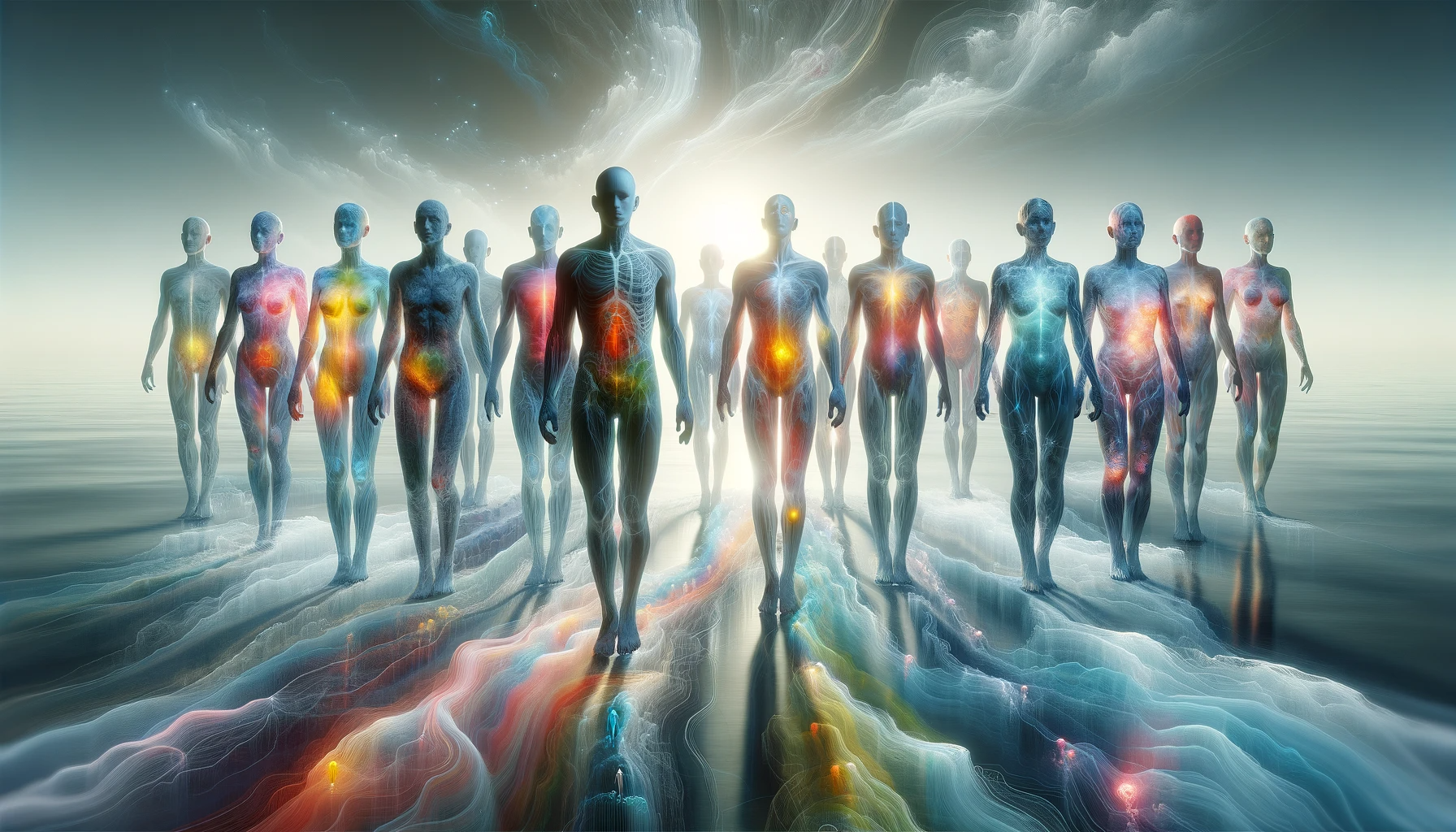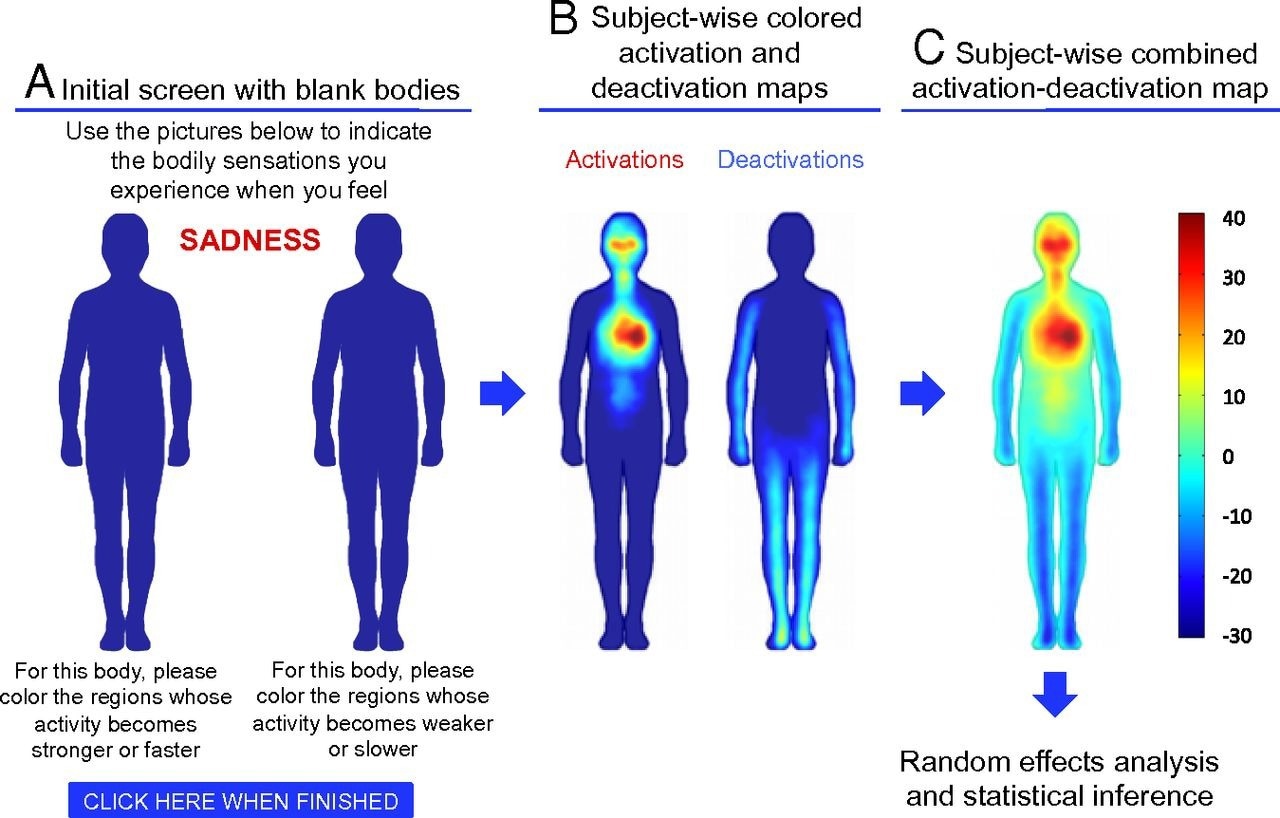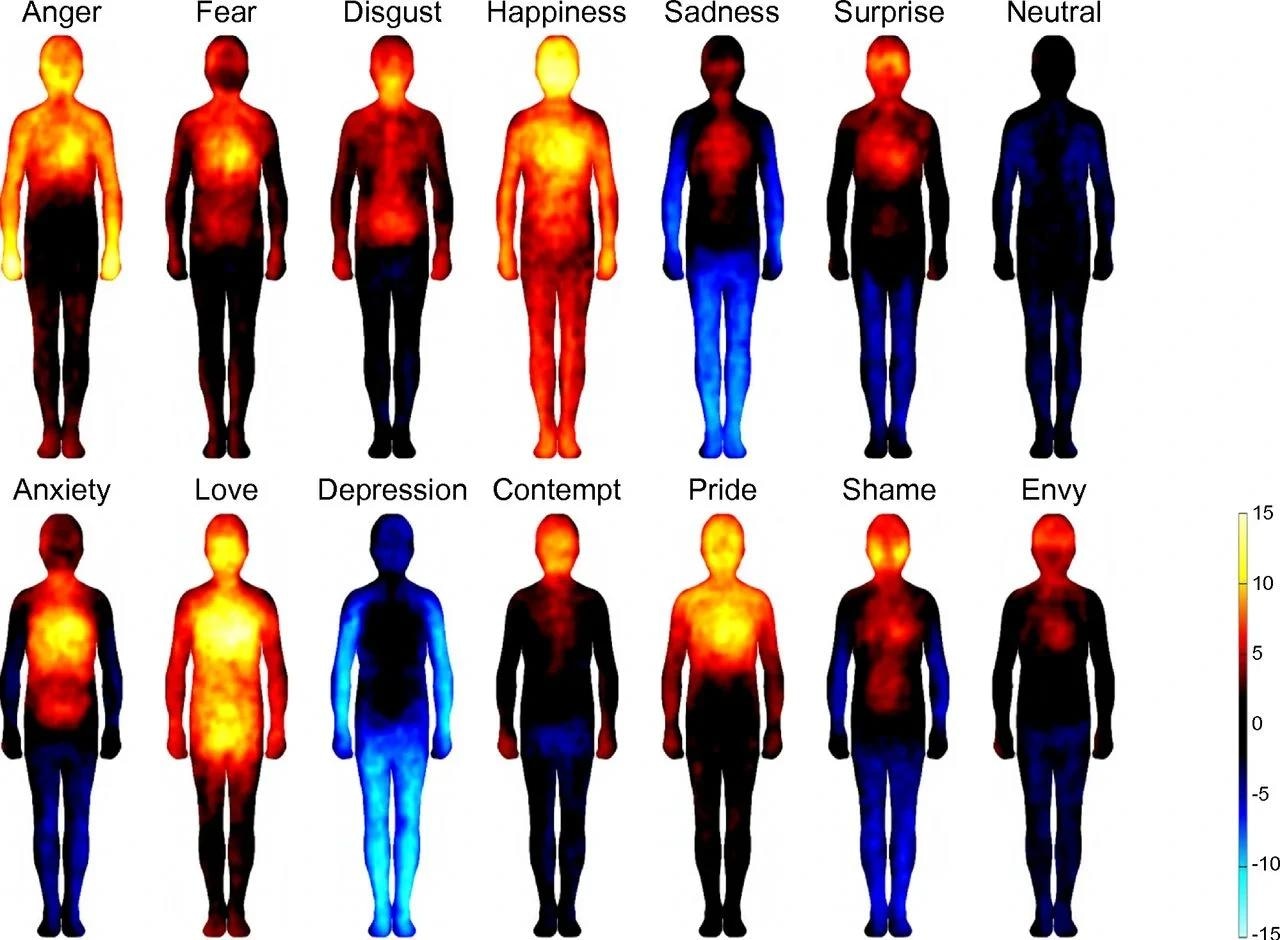In a recent study published in the journal PNAS, researchers conducted multiple experiments comprising guided stimuli and a novel topographical self-reported computer-based method named "embody" to investigate the associations between emotions and bodily topographies. They linked these emotions to cohorts from different geographies and racial backgrounds and revealed that subjective emotional feelings are associated with identifiable maps of bodily sensations. These findings support hypotheses and models wherein somatosensation and embodiment are critical aspects of emotional processing. This research forms the foundation for identifying and further delving into hitherto hard-to-understand mood disorders such as depression and anxiety, which are assumed to alter standard emotional processing.
 Research: Bodily maps of emotions.
Research: Bodily maps of emotions.
Mind over body
Have you ever experienced emotions that make you feel things in your body? You aren't alone. Humans often experience altered bodily feelings in response to their temporal emotional landscape, such as pounding hearts and light walking when on the way to meet a lover for a date in a park, as opposed to tight muscles, sweaty hands, and a choked-up throat when anxious. Neural research and studies on somatic responses to stress suggest that an individual's emotional state acts as a trigger for modifying the cardiovascular, neuroendocrine, skeletomuscular, and autonomic nervous systems (ANS) in preparation for assumed events.
More recent research has investigated the verbal descriptions of emotions and bodily states – "cold feet" is a common phrase to describe a sudden bout of anxiety and reluctance prior to a previous eagerly anticipated wedding, as is "heartbroken" is a potentially even more common description of the feelings accompanying disappointments in love. These findings suggest constant feedback between individuals' somatic, emotional, and descriptive functions, though adequate research in the field remains lacking.
Interestingly, clinical research has recently identified that our thoughts about our feelings have minute yet significant voluntary control over a previously assumed completely involuntary phenomenon – perceptions of emotion-related somatic states have been found to alter skeletomuscular, ANS, and neuroendocrine responses, suggesting that an individual's conscious perception of their environment can better fine-tune their voluntary and potentially involuntary behaviors to suit the challenges of their surroundings better.
"…it is still hotly debated whether the bodily changes associated with different emotions are specific enough to serve as the basis for discrete emotional feelings, such as anger, fear, or happiness, and the topographical distribution of the emotion-related bodily sensations has remained unknown."
Understanding the links between mind and body and revealing if the mind can actually control the body to a certain extent can help researchers both identify and treat mood disorders such as anxiety and depression and is hence essential in today's increasingly stressful world.
About the study
In the present study, researchers developed a unique computer-aided, topographical self-reporting method christened "embody." The program was designed to allow participants to visually represent and reproduce the altered bodily states they felt in response to specific, researcher-provided stimuli. Two digital silhouettes of bodies were provided to each participant who was asked to color physical regions that they felt experienced altered (increased or decreased) activity on exposure to specific, emotionally triggering words, movies, stories, or facial expressions.
The study cohort comprised 773 total volunteers separated into five cohorts corresponding to the five experimental treatments conducted herein. Most participants were Finnish-speaking except for cohorts 1b (Swedish) and 1c (Taiwanese Hokkien). Experiment 1 a-c comprised the presentation of emotionally triggering words; Experiment 2 used guided emotional imagery; Experiment 3 used emotional movies; Experiment 4 presented pictures of basic facial expressions; and Experiment 5 used emBODY bodily sensations (BSMs) averaged from Experiment 1 participants.
Statistical analyses of participant inputs were carried out using random effects analyses and mass univariate t-tests, corrected for false positives using false discovery rate (FDR) corrections with alpha levels of 0.05. Hierarchical clustering and Spearman correlations were used to assess group- and individual BSM associations, respectively.
Study findings
The present study revealed that distant distinct BSMs were associated with basic and complex emotional responses to presented stimuli. Patterns revealed by the emBODY methodology were found to be consistent across six basic emotions categorically represented in the body. Encouragingly, these categories match previously reported results from brain imagining and behavioral investigations, highlighting that the emotional systems and corresponding neural mechanisms are instrumental in emotional processing.

The emBODY tool. Participants colored the initially blank body regions (A) whose activity they felt increasing (left body) and decreasing (right body) during emotions. Subjectwise activation–deactivation data (B) were stored as integers, with the whole body being represented by 50,364 data points. Activation and deactivation maps were subsequently combined (C) for statistical analysis.
"These (emBODY) maps constitute the most accurate description available to date of subjective emotion-related bodily sensations. The discernible sensation patterns associated with each emotion correspond well with the major changes in physiological functions associated with different emotions."
A noteworthy finding is that basic emotions trigger elevated sensational responses in the upper chest area, corresponding to breathing and heart rate alterations. Approach-associated stimuli such as anger and happiness resulted in sensations in the upper limbs. Sadness, in contrast, reduced limb activity and induced a reluctance to move. Disgust prompted sensational responses in the digestive system and throat region. The head region showed alterations (increased or decreased activity) in response to all stimuli, and happiness was found to universally increase sensations across all bodily components.

Bodily topography of basic (Upper) and nonbasic (Lower) emotions associated with words. The body maps show regions whose activation increased (warm colors) or decreased (cool colors) when feeling each emotion. (P < 0.05 FDR corrected; t > 1.94). The colorbar indicates the t-statistic range.
"All cultures have body-related expressions for describing emotional states. Many of these (e.g., having "butterflies in the stomach") are metaphorical and do not describe actual physiological changes associated with the emotional response. It is thus possible that our findings reflect a purely conceptual association between semantic knowledge of language-based stereotypes associating emotions with bodily sensations. When activated, such a conceptual link—rather than actual underlying physiological changes—could thus guide the individual in constructing a mental representation of the associated bodily sensations."
While the above argument can be made, consistency between Finnish, Taiwanese, and Swedish language natives in BSM reading discredits it. Finally, complex emotions were found to be more nuanced and challenging to categorize than simple emotions. However, statistical analyses still identify complex emotional responses as discrete events.
"Unraveling the subjective bodily sensations associated with human emotions may help us to better understand mood disorders such as depression and anxiety, which are accompanied by altered emotional processing, ANS activity, and somatosensation. Topographical changes in emotion-triggered sensations in the body could thus provide a novel biomarker for emotional disorders."
Journal reference:
- Nummenmaa, L., Glerean, E., Hari, R., & Hietanen, J. K. (2014). Bodily maps of emotions. Proceedings of the National Academy of Sciences, 111(2), 646-651, DOI – https://doi.org/10.1073/pnas.1321664111, https://www.pnas.org/doi/full/10.1073/pnas.1321664111
Article Revisions
- Dec 1 2023 - Title wording change - feeling to feelings